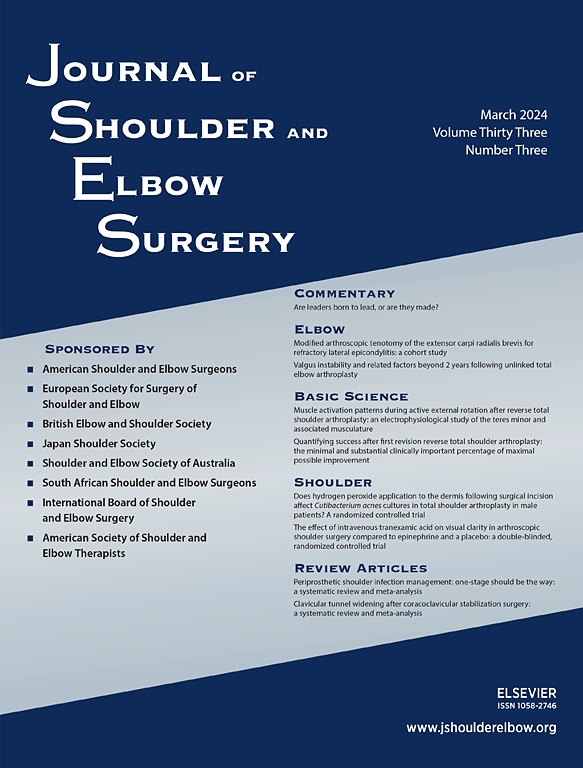
Comparing clinical and radiographic outcomes of stemless vs stemmed implants in TSA

Comparing clinical and radiographic outcomes of stemless vs stemmed implants in TSA
Is the stemless humeral head replacement clinically and radiographically a secure equivalent to standard stem humeral head replacement in the long-term follow-up? A prospective randomized trial.
J Shoulder Elbow Surg. 2017 Feb;26(2):225-232Synopsis
40 patients scheduled for total shoulder arthroplasty were randomized to either a stemless implant or a standard stemmed implant. Clinical and radiographic outcomes were assessed over 5-year follow-up. After 5 years, Constant scores did not significantly differ between groups. No cases of radiographic changes either inferior to the humeral component on the anteroposterior view or posterior to the humeral component on the axillary view were observed in the stemless group, which was significantly lower than the incidence observed in the stemmed group.
Was the allocation sequence adequately generated?
Was allocation adequately concealed?
Blinding Treatment Providers: Was knowledge of the allocated interventions adequately prevented?
Blinding Outcome Assessors: Was knowledge of the allocated interventions adequately prevented?
Blinding Patients: Was knowledge of the allocated interventions adequately prevented?
Was loss to follow-up (missing outcome data) infrequent?
Are reports of the study free of suggestion of selective outcome reporting?
Were outcomes objective, patient-important and assessed in a manner to limit bias (ie. duplicate assessors, Independent assessors)?
Was the sample size sufficiently large to assure a balance of prognosis and sufficiently large number of outcome events?
Was investigator expertise/experience with both treatment and control techniques likely the same (ie.were criteria for surgeon participation/expertise provided)?
Yes = 1
Uncertain = 0.5
Not Relevant = 0
No = 0
The Reporting Criteria Assessment evaluates the transparency with which authors report the methodological and trial characteristics of the trial within the publication. The assessment is divided into five categories which are presented below.
4/4
Randomization
4/4
Outcome Measurements
4/4
Inclusion / Exclusion
4/4
Therapy Description
2/4
Statistics
Detsky AS, Naylor CD, O'Rourke K, McGeer AJ, L'Abbé KA. J Clin Epidemiol. 1992;45:255-65
The Fragility Index is a tool that aids in the interpretation of significant findings, providing a measure of strength for a result. The Fragility Index represents the number of consecutive events that need to be added to a dichotomous outcome to make the finding no longer significant. A small number represents a weaker finding and a large number represents a stronger finding.
Why was this study needed now?
Interest in stemless humeral head implants for use in shoulder arthroplasty has increased over the past decade. Advocates of stemless humeral head replacements suggest that they offer more anatomical reconstruction of the glenohumeral joint, as well as preserve bone stock if revision is necessary. However, further randomized controlled trials were needed to compare radiographic and clinical outcomes between stemless and stemmed humeral heads in shoulder arthroplasty.
What was the principal research question?
In total shoulder arthroplasty, is there any significant difference in clinical and radiographic outcome after 2 or 5 years between a stemless implant and standard stemmed implant?
What were the important findings?
- There was no significant difference between the stemless group and the stemmed group in Constant score at 2 years (65.5+/-15.4 vs. 65.7+/-11.7, respectively; p=0.642) or 5 years (72.8+/-11.8 vs. 69.9+/-15.3, respectively; p=0.596).
- There was also no significant difference between groups in the Constant score subcategories of pain, activities of daily living, range of motion, and strength at 2 or 5 years (all p>0.05).
- On the anteroposterior view, a significantly lower number of patients demonstrated grade 1 changes (bone density loss/osteolysis) in the inferior region under the prosthesis in the stemless group (0%) compared to the stemmed group (41.2%) (p=0.009). On the axillary view, a significantly lower number of patients demonstrated either grade 1 or 2 changes (grade 2: radiolucent lines <1mm) posterior to the prosthesis in the stemless group (0%) compared to the stemmed group (grade 1: 23.5%; grade 2: 5.9%) (p=0.046)
- No other significant differences between groups were noted in the incidence of radiographic changes around either the humeral component or glenoid component.
- In the stemless group, two patients demonstrated atraumatic loosening of the glenoid component requiring revision, and one patient had rotator cuff deficiency requiring revision. In the stemmed group, one patient suffered traumatic loosening of the humeral component.
What should I remember most?
In total shoulder arthroplasty, the use of a stemless implant was associated with a lower incidence in radiographic changes inferior to the humeral component on the anteroposterior view and posterior to the humeral component on the axillary view when compared to a standard stemmed implant. No significant differences between implant types were observed after 5 years on Constant score.
How will this affect the care of my patients?
The result of this study suggest that a stemless implant in total shoulder arthroplasty may reduce the incidence in radiographic changes developed around the humeral component at mid-term follow-up when compared to a standard stemmed implant, though this does not appear to significantly affect functional outcome in the mid-term. Continued follow-up is necessary to evaluate long-term radiographic changes and survivorship of the the two types of implants.
Learn about our AI Driven
High Impact Search Feature
Our AI driven High Impact metric calculates the impact an article will have by considering both the publishing journal and the content of the article itself. Built using the latest advances in natural language processing, OE High Impact predicts an article’s future number of citations better than impact factor alone.
Continue



 LOGIN
LOGIN

Join the Conversation
Please Login or Join to leave comments.
Orthopaedic Surgeon - United States
need longer follow up